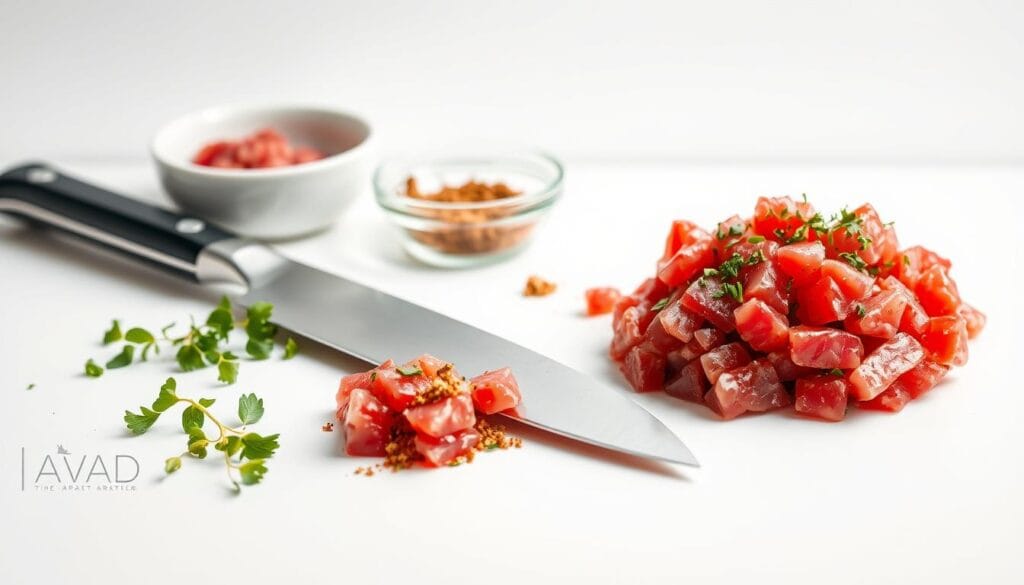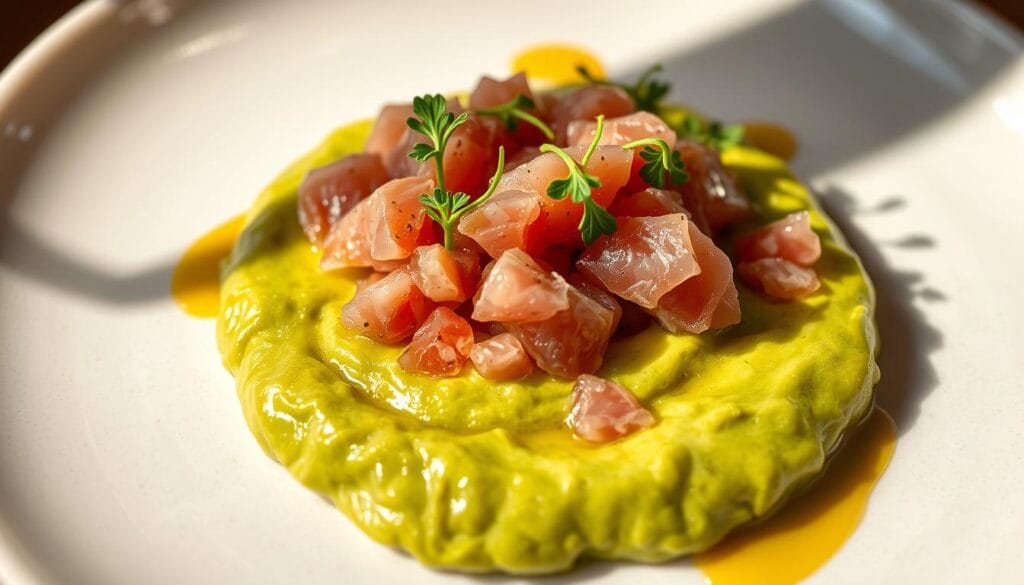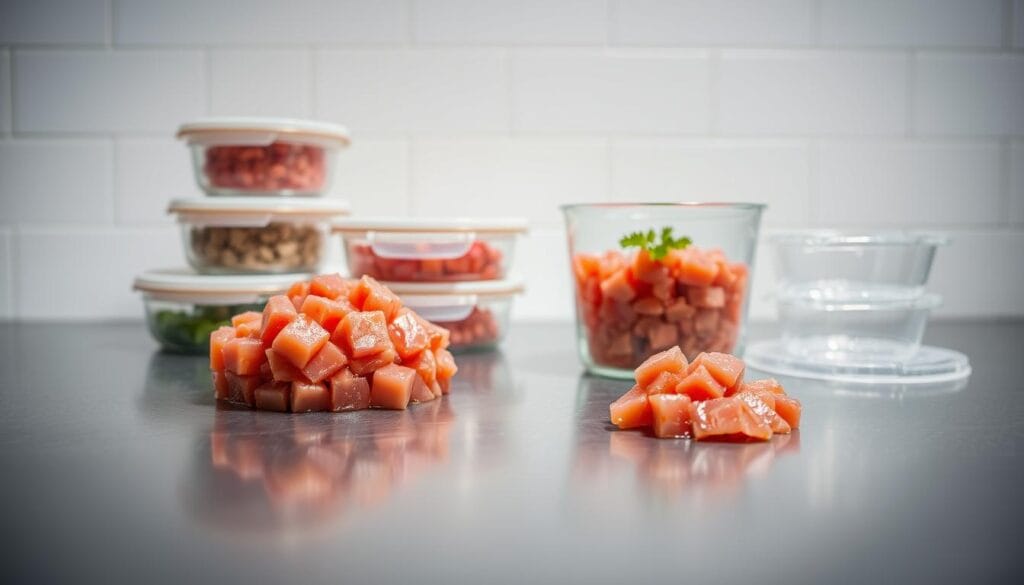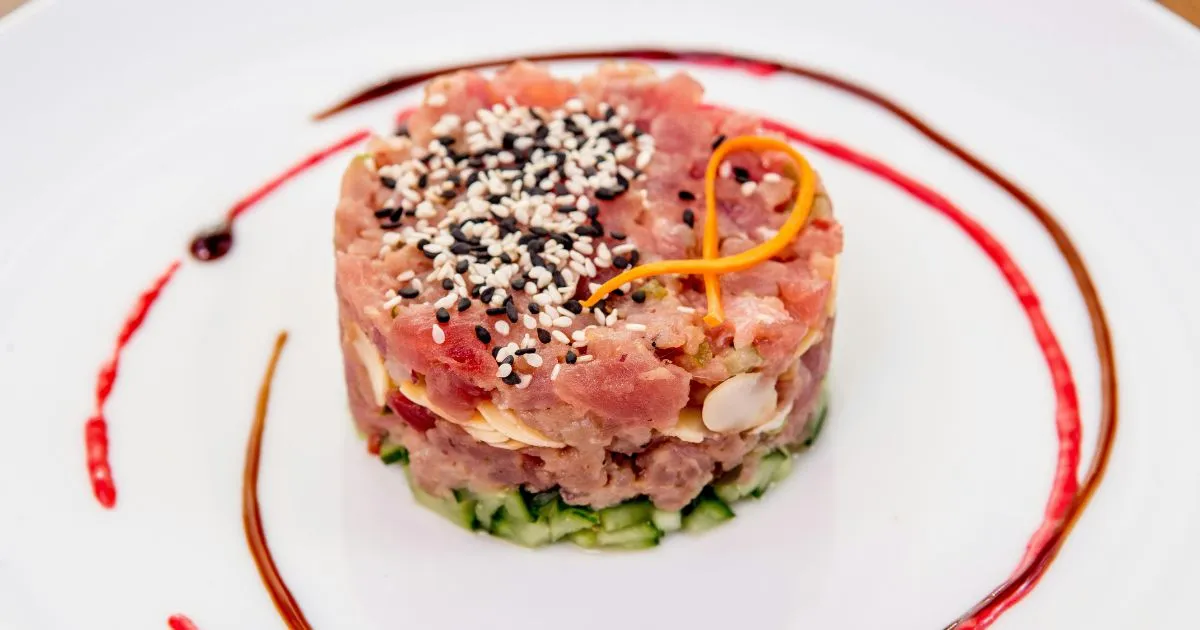
Table of Contents
Tuna tartare has become a big hit in cooking, changing how we see raw seafood. It mixes fresh tuna with careful cutting and bright flavors. Learning to make tuna tartare is easy and can make your dishes stand out.
If you love seafood or just want to try something new, tuna tartare is for you. It’s all about the right mix of texture and taste. You can make appetizers that look like they came from a fancy restaurant.
Tuna tartare is both classic and modern, offering a fancy way to cook seafood. Knowing the basics lets you make a dish that looks and tastes like it was made by a pro.
Key Takeaways
- Tuna tartare requires fresh, high-quality sushi-grade tuna
- Precise knife skills are crucial for perfect texture
- The dish can be customized with various seasonings
- Proper food safety is essential when preparing raw fish
- Tuna tartare can be a stunning appetizer or light meal
Understanding Tuna Tartare: Origins and Culinary Significance
Tuna tartare has become a global favorite, moving from a rare dish to a common delight. It showcases fresh, vibrant flavors that people love all over the world. Its story is one of culinary growth, mixing old ways with new tastes.
The French Connection: Culinary Innovation
French chefs started tuna tartare, using new ways to serve raw seafood. They built on traditional French cooking, making a dish that changed the game. In Paris, chefs worked with raw tuna, bringing out its natural taste.
- Originated in high-end Parisian restaurants
- Inspired by classic steak tartare preparations
- Emphasized fresh, high-quality seafood
Global Culinary Sensation
Tuna tartare soon became a hit worldwide, loved by chefs and diners alike. Its appeal comes from several key points:
| Factor | Appeal |
|---|---|
| Nutritional Value | High in protein, low in calories |
| Visual Presentation | Elegant and Instagram-worthy |
| Flavor Profile | Fresh, clean, adaptable to various seasonings |
Tuna tartare’s flexibility lets chefs get creative. From classic French to modern twists, it keeps growing. Now, you can find it in places from casual spots to fancy restaurants, showing its broad appeal.
Selecting the Perfect Tuna for Your Tartare
Choosing the right ahi tuna is key for a great tartare. It affects the dish’s taste, texture, and quality. Fresh, high-grade ahi is essential for a memorable tuna tartare.
- Search for sushi-grade tuna with a bright, deep red color
- Check for firm, shiny flesh without any brown spots
- Make sure the fish smells clean and ocean-like, not too fishy
Here are some top places to find premium ahi tuna:
- Specialty seafood markets
- Local fishmongers
- Reputable online seafood suppliers
| Tuna Type | Characteristics | Best for Tartare |
|---|---|---|
| Yellowfin (Ahi) | Lean, mild flavor | Excellent raw preparation |
| Bigeye Tuna | Rich, buttery texture | High-quality tartare |
Pro tip for your ahi tuna recipe: Buy from trusted sources that follow food safety. Keep it refrigerated and eat within 24 hours for the best taste and freshness.
Essential Kitchen Tools and Equipment for Tuna Tartare
To make a tasty tuna tartare, you need more than fresh ingredients. The right kitchen tools can make a big difference. They help with safety, precision, and how it looks.
Having the right tools is key for making great tuna tartare. Professional chefs know that good tools can turn a simple dish into something amazing.
Must-Have Knives and Cutting Boards
Choosing the right knife is important when working with raw tuna. Here are some essential tools:
- Sharp chef’s knife with a 8-10 inch blade
- Sashimi knife for precise cuts
- Non-porous cutting board (preferably plastic or wood)
“A sharp knife is a chef’s best friend when crafting a perfect tuna tartare.” – Culinary Experts
Serving and Presentation Equipment
Use professional tools to make your tuna tartare look great:
- Ring molds for perfect circular shapes
- Small decorative plates
- Garnishing tweezers
- Squeeze bottles for sauces
Safety and Storage Tools
Keeping raw fish safe is very important. Use these tools to protect yourself and keep ingredients fresh:
- Food-safe disposable gloves
- Airtight storage containers
- Instant-read thermometer
- Plastic wrap for immediate covering
Pro tip: Always keep your tuna tartare ingredients chilled and handle with care to ensure the best possible flavor and safety.
Preparing Your Workspace and Ingredients
Learning to make tuna tartare starts with a clean and organized workspace. This is key for both food safety and getting the dish right. Make sure your area is clean and has all the tools you need before starting.
First, collect all the ingredients and tools you’ll need. A tidy workspace makes preparing tuna tartare fun and easy.
- Sharp chef’s knife for precise cutting
- Cutting board dedicated to raw fish
- Mixing bowls of various sizes
- Measuring spoons and cups
- Refrigerated space for ingredient storage
To make great tuna tartare, focus on using the best ingredients. Choose the freshest sushi-grade tuna you can find. Make sure it’s been stored and handled correctly.
| Ingredient | Preparation Tip |
|---|---|
| Fresh Tuna | Chill before cutting, trim any connective tissue |
| Shallots | Finely mince for uniform flavor distribution |
| Herbs | Chop just before mixing to maintain freshness |
Your workspace needs to stay cool. Keep all ingredients cold. Work fast to keep the tuna’s texture right and avoid bacterial growth.
Pro tip: Always wash your hands well and use clean tools when handling raw fish. This is important for food safety while making tuna tartare.
Classic Tuna Tartare Recipe: Step-by-Step Instructions
Making the perfect tuna tartare recipe needs focus, top-notch ingredients, and skill. It turns fresh tuna into a fancy appetizer that impresses both food lovers and home cooks.
Start your tuna tartare journey by picking the best ingredients. Fresh, sushi-grade tuna is the base of a great tartare.
Base Ingredients for Authentic Flavor
- 1 pound fresh sushi-grade tuna
- 2 tablespoons extra virgin olive oil
- 1 shallot, finely minced
- 2 tablespoons fresh chives, chopped
- 1 tablespoon fresh lime juice
- Sea salt and freshly ground black pepper
Cutting Techniques for Perfect Texture
To get the right texture, cut the tuna into 1/4-inch cubes with a sharp knife. Precision is key – uneven cuts can mess up the dish’s balance.
“The beauty of tuna tartare lies in its simplicity and the quality of its ingredients.” – Professional Chef
Seasoning and Flavor Balance
Mix the ingredients gently, without crushing the tuna. Let it rest for 10-15 minutes before serving. This lets the flavors mix well. Taste and adjust the seasonings for a perfect balance of citrus, herbs, and spice.
Present it chilled on a crisp toast point or cucumber slice. This shows off the tartare’s elegant simplicity.
Creating Modern Tuna Tartare Variations with Avocado

Take your cooking to the next level by making tuna tartare with avocado. The creamy avocado pairs well with the tuna’s delicate taste. This makes for a fancy yet easy-to-make dish.
Start with the freshest tuna and avocado you can find. Your tuna poke recipe can be updated to include this tasty mix. The goal is to mix the tuna and avocado’s rich tastes without losing their essence.
- Choose sushi-grade tuna for the best results
- Use ripe but firm avocados
- Dice ingredients uniformly for optimal texture
- Chill ingredients before mixing
For a unique twist on ahi tuna poke, try these ideas:
- Diced mango for tropical sweetness
- Cucumber for crisp freshness
- Tobiko for a delicate crunch
- Sesame seeds for nutty undertones
“Great tartare is about precision and respect for ingredients.”
Your tuna tartare with avocado is a blank slate for creativity. Play with soy sauce, lime juice, or wasabi to find your favorite taste.
Plating and Presentation Techniques for Restaurant-Style Appeal
To make your poke recipes ahi look like they came from a restaurant, focus on the details. Your tuna tartare can be a feast for the eyes and taste buds. Use the right plating techniques to make it happen.
Professional chefs have tricks up their sleeves to make tuna tartare look amazing. Learning these tricks will help you make dishes that wow your guests. It will also show off your cooking skills.
Elegant Plating Strategies
- Use ring molds to create perfect cylindrical shapes
- Spread tartare in artistic swoops across white plates
- Layer different textures for visual complexity
- Incorporate contrasting color garnishes
Garnishing with Precision
Your ahi poke recipes need careful garnishing. Choose ingredients that match the fish’s flavor and look good. Here are some ideas:
- Microgreens for delicate height
- Crispy wonton chips for texture
- Edible flower petals for color
- Thin radish slices for crunch
Temperature and Timing Essentials
Serving raw fish needs careful temperature control. Keep your tuna tartare cold until just before serving. This keeps the flavor and texture at their best. Serve it right away for the freshest taste.
Pro tip: Chill serving plates in advance to keep your tartare at the perfect temperature.
Storage Tips and Food Safety Guidelines

Preparing tuna tartare needs careful attention to food safety and storage. Raw fish must be handled right to avoid foodborne illnesses and keep quality high. Knowing the right storage methods ensures you enjoy your tuna tartare safely and tastily.
Here are key guidelines for storing tuna tartare:
- Refrigerate tuna tartare right after making it
- Use an airtight container to stop contamination
- Keep it at or below 40°F (4°C)
- Eat it within 24 hours of making it
Your fridge’s temperature is key to keeping tuna tartare safe and good. Get a reliable fridge thermometer for consistent cold storage. High-risk individuals like pregnant women, young kids, older folks, and those with weak immune systems should not eat raw fish.
Food safety is not optional—it’s a must when making raw seafood dishes like tuna tartare.
Experts say use the freshest sushi-grade tuna and buy from trusted places. Always check the fish’s quality before making your tuna tartare. Look for a bright, firm texture and a clean ocean smell.
Conclusion
Making the perfect tuna tartare is a fun journey that mixes easy steps with rich flavors. You’ll see how easy and flexible fish tartare can be in your kitchen. With the right tools and ingredients, you can turn simple tuna into a fancy appetizer that wows everyone.
The secret to great tuna tartare is using top-notch, fresh fish and following food safety rules. Every time you make it, you’ll get better at cutting and mixing flavors. Feel free to try new spices, toppings, and ways to serve it to show off your style.
Exploring fish tartare opens up a whole new world of cooking. The skills you learn with tuna work with other fish too, making your cooking even more exciting. You’ll not only improve your cooking but also have a quick, healthy, and impressive dish ready for any event.
Begin with the basic recipe, practice your skills, and watch your tuna tartare abilities grow. Every time you make it, you get to improve and create something amazing in your kitchen.
FAQ
What type of tuna is best for tartare?
Ahi tuna, like yellowfin or bigeye, is top for tartare. Look for sushi-grade tuna that’s fresh and has a bright color. It should also smell clean and not fishy. Buy it from a trusted fishmonger or seafood market for the best quality and safety.
Is it safe to eat raw tuna?
Eating raw tuna is safe if you use sushi-grade fish and follow food safety rules. Make sure to buy fresh, high-quality fish from a reliable source. Keep it cold and eat it fast. People with weak immune systems, pregnant women, and young kids should talk to a doctor before eating raw fish.
How do I know if the tuna is fresh enough for tartare?
Fresh tuna for tartare should be bright red, have little liquid, and smell like the ocean. It should feel firm and shiny. Avoid tuna that smells fishy, has brown or gray spots, or feels slimy.
How long can I store tuna tartare?
Tuna tartare should be eaten right away or within 24 hours. Store it in a sealed container in the coldest part of your fridge at 40°F or below. Never let raw fish sit at room temperature for more than two hours.
Can I freeze tuna for tartare?
Freezing tuna is possible, but not ideal for tartare. Freezing can ruin the fish’s texture and flavor. If you must freeze, use sushi-grade tuna and freeze it at 0°F. Use it within 2-3 months for the best taste.
What are some popular accompaniments for tuna tartare?
Popular sides include crispy wonton chips, toasted sesame seeds, and microgreens. Avocado, cucumber, and sauces like soy sauce or wasabi aioli are also great. You can serve it with crackers, rice crackers, or on a bed of greens.
How do I cut tuna for tartare?
Use a sharp knife to cut the tuna into small, uniform cubes, about 1/4 inch. Make sure your cutting board is clean and won’t absorb moisture. Cut against the fish’s grain to keep it firm and prevent bruising.
Can I make a vegetarian version of tartare?
Yes, you can make vegetarian tartare using ingredients like diced hearts of palm, watermelon, or beets. These can be seasoned and cut like fish tartare to mimic its texture.



2 thoughts on “How to Make Tuna Tartare: A Simple Guide the best in 2025”